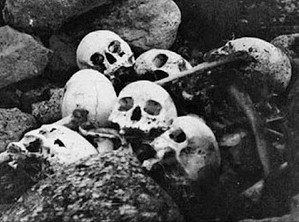In archaeology, we are constantly getting updates on old material. When results are released, it isn’t always when the study itself is complete. Further, new methods or techniques may lead to re-analysis of older sites and remains, revealing new conclusions. Updates on old topics can cause increased debate, or end arguments completely depending on the evidence presented. In today’s post, we’re going to look at some updates and new finds that add to older archaeological discussions.

Badgers Behaving Badly, Amazing Illustration by Kim Harris and via Full Frog Moon. To see her imaginative interpretation of why badgers are disturbing cemeteries, click on the illustration!
1. Badgers continue to disrupt cemeteries and archaeological sites: In October 2010, I discussed animal disturbance at various types of mortuary sites, primarily how badgers were disturbing cemeteries. It turns out this wasn’t just a one time event. In fact, badgers seem to be continually getting into mortuary sites. At a cemetery in Swindon recently there has been a problem of badgers tunneling under coffins, and even removing human remains from the graves. Mark Sutton commented on the event: “In some places they have burrowed right under the graves, toppling some headstones and more disturbingly, depositing human bones on the surface,” he told the paper. “Two or three years ago I received a phone call from a distressed person to say vandals had struck. I visited the cemetery to see the grass completely torn up. I have never seen it so bad. It wasn’t vandals but the very cute badgers” (Moye 2012).Most recently, the cemetery where poet Dylan Thomas is buried has been disturbed by badgers. This cemetery is part of a literary tour due to its famous occupant, and now the grounds look like they’ve been ploughed due to the badger tunneling (BBC 2013). Moving the animals requires applying for a license, getting permission, and it is an expensive process.
2. Basketmaker II Cave 7 site, massacre site or burial site debate continues: The Basketmaker II Cave 7 site has been highly debated for decades over whether it represents the site of a massacre or a normal burial site. It was first discovered in the late 19th century, and recovered over 100 burials, many of which showed blunt force trauma. Others had projectile points embedded in their bones or were recovered in association with projectiles or weapons. The frequency of these injuries was determined to indicate that the assemblage was the result of a single-event massacre. A recent article by Coltrain et al. (2012) argued that it was not massacre, but rather a burial site. They re-examined trauma to determine that many were not as dramatic as previously thought, and demographic re-analysis showed it wasn’t all males. Finally, they used radiocarbon dates to determine the burials were amassed over a long period of time, not a single event. A new study by Geib and Hurst (2013) proposes that the context of burial supports the conclusion that portions of the assemblage represent a massacre, and that radiocarbon dates should not trump this information. They posit that the layout of remains within the cave points to multiple internments with one major massacre deposit of 58 individuals. They conclude that radiocarbon dates are not completely accurate and can have a wide range of error- therefore other evidence is needed to support their dates. It seems that the debate continues regarding the nature of this site.
3. We still don’t know what happened to the Franklin Expedition: A recent study by Mays, Maat, and de Boer (2013) found that scurvy was not the cause for the downfall of the Franklin Expedition despite historic records arguing that scurvy-like symptoms caused major sickness and was the reason they left their ship and trekked across the ice (the ultimate cause of their deaths). Based on artifact evidence of canning, it was instead proposed that lead poisoning may have been the cause of their sickness and behavior. Further, high levels of lead were found present in the human remains. A new study by Martin et al. (2013) used Synchrotron micro-X-ray Fluorescence to map the distribution of metal within bone fragments associated with the Franklin expedition. They concluded that the distribution of the lead, though high, is representative of a lifetime of ingestion rather than short term exposure over a number of years during the expedition. This means we still don’t know what really happened- though continued study may help narrow down the possibilities.
One quick final update, they’ve found another Romeo and Juliet style burial with a male and female buried together hand in hand. They were found in Romania, and date to the 15th century. Evidence of love? We’ll never know- but it is interesting that we’re finding more of this style burial. What does it represent? Probably different things for each culture, but its interesting to see a pattern arise!
Works Cited
![]() Geib, P., & Hurst, W. (2013). Should dates trump context? Evaluation of the Cave 7 skeletal assemblage radiocarbon dates Journal of Archaeological Science, 40 (6), 2754-2770 DOI: 10.1016/j.jas.2013.01.034
Geib, P., & Hurst, W. (2013). Should dates trump context? Evaluation of the Cave 7 skeletal assemblage radiocarbon dates Journal of Archaeological Science, 40 (6), 2754-2770 DOI: 10.1016/j.jas.2013.01.034
Coltrain, J., Janetski, J., & Lewis, M. (2012). A re-assessment of Basketmaker II cave 7: massacre site or cemetery context Journal of Archaeological Science, 39 (7), 2220-2230 DOI: 10.1016/j.jas.2012.02.018
Martin, R., Naftel, S., Macfie, S., Jones, K., & Nelson, A. (2013). Pb distribution in bones from the Franklin expedition: synchrotron X-ray fluorescence and laser ablation/mass spectroscopy Applied Physics A, 111 (1), 23-29 DOI: 10.1007/s00339-013-7579-5
Moye 2012. Grave Robbing Badgers Dig up British Cemetery. Huffington Post. http://www.huffingtonpost.com/2012/02/28/grave-robbing-badgers-dig-up-british-cemetery_n_1308190.html
BBC 2013. Dylan Thomas cemetery in Laugharne damaged by badgers. BBC News
http://www.bbc.co.uk/news/uk-wales-south-west-wales-22015691
Romanian Insider 2013. Romanian archaeologists uncover Romeo and Juliet. http://www.romania-insider.com/romanian-archeologists-uncover-romeo-juliet-medieval-couple-buried-together-with-hands-clasped/80224/

